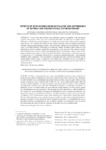Please use this identifier to cite or link to this item:
http://www.alice.cnptia.embrapa.br/alice/handle/doc/463637| Title: | Effects of isoflavones on beany flavor and astringency os soymilk and cooked whole soybean grains. |
| Authors: | CARRÃO-PANIZZI, M. C.  BELÉIA, A. D. P.   PRUDÊNCIO-FERREIRA, S. H.   OLIVEIRA, M. C. N.   KITAMURA, K.   |
| Date Issued: | 1999 |
| Citation: | Pesquisa Agropecuária Brasileira, Brasília, v. 34, n. 6, p. 1045-1052, jun. 1999. |
| Description: | Flavor is the main limiting factor affecting soybean acceptability in the Occidental countries. The purpose of this study was to determine the effetcs of isoflavones on soybean flavor. Differences in beany flavor and astringency of soymilk and cooked whole soybean grains, prepared with cultivars IAS 5 and BR-36 (136 and 54 mg of total isoflavones /100 g of sample, respectively) with pre-soaking and pre-heating of grains, were sensorially analyzed, by an unstructured category scale of ascending intensity. Differences in isoflavone contents for both soybean cultivars were maintained in the two products, despite the pre-treatments in the processing. Pre-soaking of grains intensified beany flavor in the soymilk, reducing the perception of astringency, which is caused by the aglucones that were developed in reduced amounts.The whole soybeans grains cooked under pressure (1.5 kgf/cm2 at 127°C) presented reduced levels of isoflavones malonyl-glucosides. Due to thermal instability, these compounds were converted to conjugated glucosides, genistin and daidzin. In the cooked whole soybean grains, no aglucones were formed and consequently it was not possible to detect differences in astringency. Results suggest that pre-heating of grains promote better flavor in soybean products. |
| Thesagro: | Leite de Soja |
| Type of Material: | Artigo de periódico |
| Access: | openAccess |
| Appears in Collections: | Artigo em periódico indexado (CNPSO)  |
Files in This Item:
| File | Description | Size | Format | |
|---|---|---|---|---|
| pab97228ing.pdf | 46.03 kB | Adobe PDF |  View/Open |









